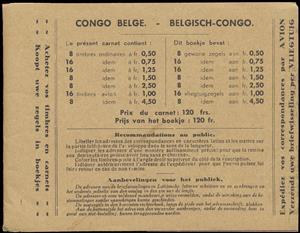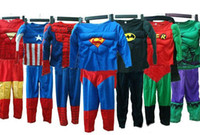Booklet: Booklet "Peoples and Views of Congo" (Belgian Congo 1937)
Booklet "Peoples and Views of Congo" (Belgian Congo 1937)
01 January (Belgian Congo ) within release Peoples and Views of Congo goes into circulation Booklet Booklet "Peoples and Views of Congo" face value 120 Belgian franc
| Booklet Booklet "Peoples and Views of Congo" in catalogues | |
|---|---|
| Belgium: | Bel: BE-CD BA5 |
Booklet is square format.
Buff-colored cover. Contains 10 sheets (booklet panes) of 8 stamps: - 8 stamps of 0.50c Mi:BE-CD 135 (Bel:BE-CD 173) - 16 stamps of 0.75c Mi:BE-CD 137 (Bel:BE-CD 175) - 16 stamps of 1.25fr Mi:BE-CD 139 (Bel:BE-CD 177) - 8 stamps of 1.50fr Mi:BE-CD 171 (Bel:BE-CD 177A) - 8 stamps of 2.50fr Mi:BE-CD 172 (Bel:BE-CD 178A) - 16 stamps of 1fr air post Mi:BE-CD 148 (Bel:BE-CD PA8) - 8 stamps of 4.50fr air post Mi:BE-CD 151 (Bel:BE-CD PA11) On page 2: bilingual postage rates Publicity on page 3 "Vélo Van Hauwaert" and on the back: "Ligue du Souvenir Congolais" 15 dividers with publicity rectoBooklet Booklet "Peoples and Views of Congo" it reflects the thematic directions:
An aircraft (pl. aircraft) is a vehicle that is able to fly by gaining support from the air. It counters the force of gravity by using either static lift or the dynamic lift of an airfoil, or, in a few cases, direct downward thrust from its engines. Common examples of aircraft include airplanes, rotorcraft (including helicopters), airships (including blimps), gliders, paramotors, and hot air balloons.Part 1 (Definitions and Abbreviations) of Subchapter A of Chapter I of Title 14 of the U. S. Code of Federal Regulations states that aircraft "means a device that is used or intended to be used for flight in the air."
Animals are multicellular, eukaryotic organisms of the kingdom Animalia (also called Metazoa). All animals are motile, meaning they can move spontaneously and independently, at some point in their lives. Their body plan eventually becomes fixed as they develop, although some undergo a process of metamorphosis later on in their lives. All animals are heterotrophs: they must ingest other organisms or their products for sustenance.
Aviation is the practical aspect or art of aeronautics, being the design, development, production, operation and use of aircraft, especially heavier than air aircraft. The word aviation was coined by French writer and former naval officer Gabriel La Landelle in 1863, from the verb avier (synonymous flying), itself derived from the Latin word avis ("bird") and the suffix -ation.
Headgear may be worn for protection against cold (such as the Canadian tuque), heat, rain and other precipitation, glare, sunburn, sunstroke, dust, contaminants, etc. Helmets are worn for protection in battle or against impact, for instance when riding bicycles or motor vehicles. There are also hats that are worn for protection from the cold
Mammals are any vertebrates within the class Mammalia (/məˈmeɪli.ə/ from Latin mamma "breast"), a clade of endothermic amniotes distinguished from reptiles (including birds) by the possession of a neocortex (a region of the brain), hair, three middle ear bones and mammary glands. All female mammals nurse their young with milk, secreted from the mammary glands. Mammals include the largest animals on the planet, the great whales. The basic body type is a terrestrial quadruped, but some mammals are adapted for life at sea, in the air, in trees, underground or on two legs. The largest group of mammals, the placentals, have a placenta, which enables the feeding of the fetus during gestation. Mammals range in size from the 30–40 mm (1.2–1.6 in) bumblebee bat to the 30-meter (98 ft) blue whale. With the exception of the five species of monotreme (egg-laying mammals), all modern mammals give birth to live young. Most mammals, including the six most species-rich orders, belong to the placental group. The largest orders are the rodents, bats and Soricomorpha (shrews and allies). The next three biggest orders, depending on the biological classification scheme used, are the Primates (apes and monkeys), the Cetartiodactyla (whales and even-toed ungulates), and the Carnivora (cats, dogs, seals, and allies).
In clothing, a suit is a set of garments made from the same cloth, usually consisting of at least a jacket and trousers. Lounge suits (also known as business suits when sober in colour and style), which originated in Britain as country wear, are the most common style of Western suit. Other types of suit still worn today are the dinner suit, part of black tie, which arose as a lounging alternative to dress coats in much the same way as the day lounge suit came to replace frock coats and morning coats; and, rarely worn today, the morning suit. This article discusses the lounge suit (including business suits), elements of informal dress code.
In the visual arts, a cityscape (urban landscape) is an artistic representation, such as a painting, drawing, print or photograph, of the physical aspects of a city or urban area. It is the urban equivalent of a landscape. Townscape is roughly synonymous with cityscape, though it implies the same difference in urban size and density (and even modernity) implicit in the difference between the words city and town. In urban design the terms refer to the configuration of built forms and interstitial space.
A woman is an adult female human. Before adulthood, a woman is referred to as a girl (a female child or adolescent)







